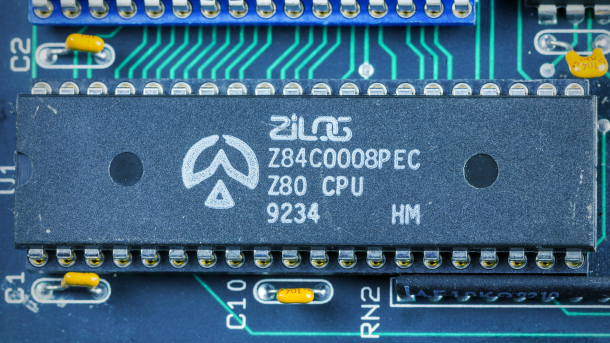Zilog Z80: The processor that taught Intel to fear is finally discontinued
After 48 years, production of the Zilog Z80, one of the most important 8-bit processors, is discontinued. A wistful look back.

Here is a Z80 processor in the 8 MHz version.
(Bild: Raimond Spekking, CC BY-SA 4.0/Bearbeitung: Markus Will)
The news makes nerds wistful: production of the Z80 processor, one of the most versatile 8-bit processors ever, is being discontinued after almost 48 years. The manufacturer announced the end of production of the legendary 8-bit processor (PDF) in a relatively unadorned announcement.
First thought: It was still being built? Sure []-- the Z80 was intended to be used for various purposes right from the start: From arcade machines, to home computers, to workstations or the first PCs. The Z80 was installed in many computers of the pioneering era and can still be found today in printers, household appliances and embedded systems. In short, it has been hard to ignore over the past three decades. Its versatility, low price and loose licensing policy made it a perennial favorite.
The processor originated from a dispute between Federico Faggin and Intel: he was dissatisfied with the standing of microprocessor development at Intel. The company preferred to make money from memory chips rather than processors. Faggin left Intel in October 1984 and founded the company Zilog in Silicon Valley with former Intel colleague Ralph Ungermann to develop his own processor.
The company name was made up of "Z integrated logic", with the Z standing for the last word in integrated logic – they wanted to have the last word in it. The processor was to be compatible, but better than the Intel 8080. A small team led by Faggin, who also brought Masatoshi Shima, another important Intel developer, on board in 1975, worked on this.
Z80 in an efficient design
In 1976, the time had come: the Z80 was presented and it was an Intel shock. It was not pin-compatible but binary-compatible with the Intel 8080, and it also received some improvements: It got by with a 5-volt supply voltage and didn't need three like the Intel (+5V/-5V/+12V), clock generation is integrated, as is refresh control for working memory. The 8080 required external components for this.
Due to the compatibility with the 8080, the CP/M operating system also ran on the processor, which was a real killer argument in the days before Windows and Office. Programs such as the WordStar writing program, the DBase database and the VisiCalc spreadsheet were decisive reasons for using a computer for business purposes. Thanks to the Z80 processor, which cost only a fraction of the 360-dollar 8080, PC technology also became affordable.
(Bild: Markus Will)
The success of the Z80 with CP/M was described by c't veteran Detlef Grell in the background article on the history of CP/M:
"When designing the Z80, Faggin then incorporated everything he thought could be improved on the 8080. The success of the Z80 was so resounding that in my entire career, including my studies, I have not come across a single CP/M computer with an 8080 processor. However, according to my colleague Andreas Stiller, a Siemens computer with an 8085, the slightly improved 8080, once found its way into the editorial office."
The market success even went so far that the first hardware product from Microsoft was a Z80 expansion card for the Apple II to be able to use CP/M on it. In addition to the MOS 8502, the Commodore 128 also had a Z80 processor on board for precisely this purpose. The Osborne 1 was also the first portable computer ever to come onto the market, with a Z80-ZPU and CP/M operating system. In the Eastern Bloc in the 1980s, Z80 replicas such as the MME U880 were used, which only disappeared with the fall of the Berlin Wall.
Processor for vending machines and home computers
But the Z80 was also a success outside professional use. It was used in many home computers: it was installed in various computers from Tandy, in the ZX-Spectrum as well as in the Amstrad CPC series, which recently celebrated its 40th birthday. In addition to home computers, vending machines were also a market for the processor: it was at home in various arcade machines, such as Galaxian or Pac-Man. Z80 or license replicas were also found in various consoles: The processor was installed in the Sega Master System, Game Gear and Mega Drive (the latter as a coprocessor). Nintendo also used it, albeit in a modified form: A slightly modified Z80 clone from Sharp was used in various versions of the Game Boy series.
It was also later used for school-leaving exams: It found its way into the pocket calculators of the TI-84-Plus series - they are still part of the pocket calculators approved for A-level exams today. Our c't colleague Tim Gerber clearly disliked the oligopoly-securing practice years ago. The Z80 was also used in other products such as synthesizers, printers and other everyday devices - it was a reliable and simple processor. The 16-bit successor Zilog Z8000 did not even come close to the success of the Z80 - Intel did far better in this field.
It was difficult to avoid in the 1980s and 1990s. Many IT and programming careers began with this processor. Above all, however, it was the first incisive contact with computer technology for many. Orders are still being accepted until June, when manufacturer Zilog will discontinue production of the Z80 in its original form. Ironically, Zilog announced the end of the Z80 almost to the day on the 50th anniversary of its predecessor: The Intel 8080 was introduced in April 1974. However, the Z80 exceeded the lifespan of the 8080 by a whopping 34 years - Intel's processor had already ended production in 1990. This means that the Z80 was on the market three times as long as its rival - at least, Zilog definitely has the last word on this.
(mawi)